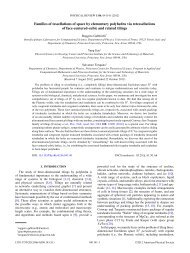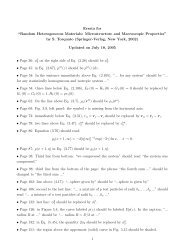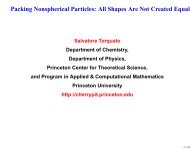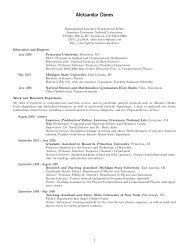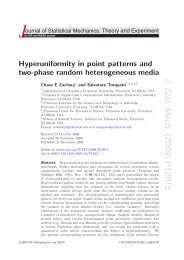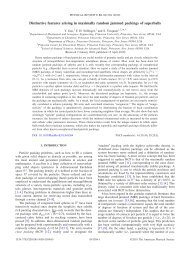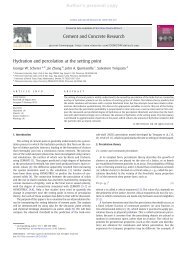Statistical properties of determinantal point processes in high ...
Statistical properties of determinantal point processes in high ...
Statistical properties of determinantal point processes in high ...
You also want an ePaper? Increase the reach of your titles
YUMPU automatically turns print PDFs into web optimized ePapers that Google loves.
SCARDICCHIO, ZACHARY, AND TORQUATO PHYSICAL REVIEW E 79, 041108 2009<br />
Similar connections have not yet been found, to the best<br />
<strong>of</strong> our knowledge, for <strong>high</strong>er-dimensional <strong>determ<strong>in</strong>antal</strong><br />
<strong>po<strong>in</strong>t</strong> <strong>processes</strong>, and numerical and analytical results <strong>in</strong> dimension<br />
d3 are miss<strong>in</strong>g altogether. In this paper and its<br />
companion 6, we provide a generalization <strong>of</strong> these <strong>po<strong>in</strong>t</strong><br />
<strong>processes</strong> to <strong>high</strong>er dimensions, which we call Fermi-sphere<br />
<strong>po<strong>in</strong>t</strong> <strong>processes</strong>. While <strong>in</strong> 6 we have studied, ma<strong>in</strong>ly by<br />
way <strong>of</strong> exact analyses, statistical descriptors such as<br />
n-particle probability densities and nearest-neighbor functions<br />
for these <strong>po<strong>in</strong>t</strong> <strong>processes</strong>, here we base most <strong>of</strong> our<br />
analysis on an efficient algorithm 7 for generat<strong>in</strong>g configurations<br />
from arbitrary <strong>determ<strong>in</strong>antal</strong> <strong>po<strong>in</strong>t</strong> <strong>processes</strong> and are<br />
therefore able to study other particle and void statistics related<br />
to nearest-neighbor distributions and Voronoi cells.<br />
In particular, after present<strong>in</strong>g <strong>in</strong> detail our implementation<br />
<strong>of</strong> an algorithm 7 to generate configurations <strong>of</strong> homogenous,<br />
isotropic <strong>determ<strong>in</strong>antal</strong> <strong>po<strong>in</strong>t</strong> <strong>processes</strong>, we study several<br />
statistical quantities there<strong>of</strong>, <strong>in</strong>clud<strong>in</strong>g Voronoi cell statistics<br />
and distributions <strong>of</strong> m<strong>in</strong>imum and maximum nearestneighbor<br />
distances for which no analytical results exist.<br />
Additionally, the large-r behavior <strong>of</strong> the nearest-neighbor<br />
functions is computationally explored. We provide substantial<br />
evidence that the conditional probabilities G P and G V,<br />
def<strong>in</strong>ed below, are asymptotically l<strong>in</strong>ear, and we give estimates<br />
for their slopes as a function <strong>of</strong> dimension d between<br />
one and four.<br />
The plan <strong>of</strong> the paper is as follows. Section II provides a<br />
brief review <strong>of</strong> <strong>determ<strong>in</strong>antal</strong> <strong>po<strong>in</strong>t</strong> <strong>processes</strong> and def<strong>in</strong>es the<br />
statistical quantities used to characterize these systems. Of<br />
particular importance is the formulation <strong>of</strong> the probability<br />
distribution functions govern<strong>in</strong>g nearest-neighbor statistics<br />
as determ<strong>in</strong>ants <strong>of</strong> NN matrices; the results are easily<br />
evaluated numerically. The term<strong>in</strong>ology we develop is then<br />
applied to the statistical <strong>properties</strong> <strong>of</strong> known one- and twodimensional<br />
<strong>determ<strong>in</strong>antal</strong> <strong>po<strong>in</strong>t</strong> <strong>processes</strong> <strong>in</strong> Sec. III. Section<br />
IV discusses the implementation <strong>of</strong> an algorithm for<br />
generat<strong>in</strong>g <strong>determ<strong>in</strong>antal</strong> <strong>po<strong>in</strong>t</strong> <strong>processes</strong> <strong>in</strong> any dimension d,<br />
and we comb<strong>in</strong>e the results from this algorithm and the numerics<br />
<strong>of</strong> Sec. II to characterize the so-called Fermi-sphere<br />
<strong>po<strong>in</strong>t</strong> process for d=1, 2, 3, and 4. In Sec. V we provide an<br />
example <strong>of</strong> a <strong>determ<strong>in</strong>antal</strong> <strong>po<strong>in</strong>t</strong>-process on a curved space<br />
a two-sphere, and our conclusions are collected <strong>in</strong> Sec. VI.<br />
II. FORMALISM OF DETERMINANTAL POINT<br />
PROCESSES<br />
A. Def<strong>in</strong>itions: n-particle correlation functions<br />
Consider N <strong>po<strong>in</strong>t</strong> particles <strong>in</strong> a subset <strong>of</strong> d-dimensional<br />
Euclidean space ER d . It is convenient to <strong>in</strong>troduce the<br />
Hilbert space structure given by square <strong>in</strong>tegrable functions<br />
on E; we will adopt Dirac’s bra-ket notation for these functions.<br />
Unless otherwise specified, all <strong>in</strong>tegrals are <strong>in</strong>tended to<br />
extend over E. A <strong>determ<strong>in</strong>antal</strong> <strong>po<strong>in</strong>t</strong> process can be def<strong>in</strong>ed<br />
as a stochastic <strong>po<strong>in</strong>t</strong> process such that the jo<strong>in</strong>t probability<br />
distribution PN <strong>of</strong> N <strong>po<strong>in</strong>t</strong>s is given as a determ<strong>in</strong>ant <strong>of</strong> a<br />
positive, bounded operator H <strong>of</strong> rank N:<br />
PNx1, ...,xN = 1<br />
N! detHxi,x j1i,jN, 1<br />
where Hx,y is the kernel <strong>of</strong> H. In this paper, we focus on<br />
the simple case <strong>in</strong> which the N nonzero eigenvalues <strong>of</strong> H are<br />
041108-2<br />
all 1; the more general case can be treated with m<strong>in</strong>or<br />
changes 7. We can write down the spectral decomposition<br />
<strong>of</strong> H as<br />
N<br />
H = n=1<br />
0 0<br />
nn, 2<br />
0 N<br />
where nn=1 are the eigenvectors <strong>of</strong> the operator H. The<br />
reason for the superscript on the basis vectors will be clarified<br />
momentarily. The correct normalization <strong>of</strong> the <strong>po<strong>in</strong>t</strong> process<br />
is obta<strong>in</strong>ed easily s<strong>in</strong>ce 1<br />
detHxi,x j1i,jNdx 1 ¯ dxN = N! detH, 3<br />
where the last determ<strong>in</strong>ant is to be <strong>in</strong>terpreted as the product<br />
<strong>of</strong> the nonzero eigenvalues <strong>of</strong> the operator H. S<strong>in</strong>ce these<br />
eigenvalues are all unity we obta<strong>in</strong> detH=1, which yields<br />
P Nx 1, ...,x Ndx 1 ¯ dx N =1. 4<br />
0 N<br />
Notice that <strong>in</strong> terms <strong>of</strong> the basis nn=1 we can also<br />
write<br />
PNx1, ...,xN = 1<br />
N! det 0<br />
i xj1i,jN 2 . 5<br />
An easy pro<strong>of</strong> is obta<strong>in</strong>ed by consider<strong>in</strong>g the square matrix<br />
0<br />
. Then,<br />
0<br />
ij= i xj=x j i<br />
0<br />
deti xj1i,jN 2 = det † det = det † <br />
j<br />
N<br />
0 0<br />
= detxi nnx n=1<br />
= detHxi,x j, 6<br />
which is the same as 1.<br />
Determ<strong>in</strong>antal <strong>po<strong>in</strong>t</strong> <strong>processes</strong> are peculiar <strong>in</strong> that one can<br />
actually write all the n-particle distribution functions explicitly.<br />
The n-particle probability density, denoted by<br />
nx1,...,xn is the generic probability density <strong>of</strong> f<strong>in</strong>d<strong>in</strong>g n<br />
particles <strong>in</strong> volume elements around the given positions<br />
x1,...,xn, irrespective <strong>of</strong> the rema<strong>in</strong><strong>in</strong>g N−n particles. For<br />
a general <strong>determ<strong>in</strong>antal</strong> <strong>po<strong>in</strong>t</strong> process this function takes the<br />
form<br />
nx 1, ...,x n = detHx i,x j 1i,jn. 7<br />
In particular, the s<strong>in</strong>gle-particle probability density is<br />
1x1 = Hx1,x 1. 8<br />
This function is proportional to the probability density <strong>of</strong><br />
f<strong>in</strong>d<strong>in</strong>g a particle at x1, also known as the <strong>in</strong>tensity <strong>of</strong> the<br />
<strong>po<strong>in</strong>t</strong> process. One can see that the normalization is<br />
1xdx =trH = N. 9<br />
For translationally <strong>in</strong>variant <strong>processes</strong> 1x=, <strong>in</strong>dependent<br />
<strong>of</strong> x. We remark <strong>in</strong> pass<strong>in</strong>g that for a f<strong>in</strong>ite system translational<br />
<strong>in</strong>variance is def<strong>in</strong>ed <strong>in</strong> the sense <strong>of</strong> averag<strong>in</strong>g the



